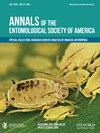Quid Pro Quo? A Review on Bee Utilization of Pollinator-Independent Crops
IF 1.8
3区 农林科学
Q1 ENTOMOLOGY
引用次数: 2
Abstract
Abstract Previous exploration has found that bee visitation tends to benefit yields of many pollinator-independent crops. However, the reverse of this relationship—if pollinator-independent crops benefit bees—has not been extensively studied or explicitly reviewed. Therefore, we initiated a review of the literature using Web of Science and EBSCOhost to determine whether: 1) bees collect pollen from pollinator-independent crops, and 2) pollinator-independent crops provided adequate nutrition for bees.These factors help establish if pollinator-independent crops could benefit bees. We found 45 peer-review articles that included bee pollen trap data on 13 pollinator-independent crops (self-pollinating and wind-pollinated plants), with Zea mays, Brassica napus, and Glycine max pollen most often found in pollen traps. Pollinator-independent crops averaged 12% of total pollen loads, but due to high variability, the median was only 1.6%. Pollen from pollinator-independent crops increased in landscapes with more agricultural cover, but our data was heavily skewed towards honey bees (Apis mellifera). We found the average crude protein for B. napus and G. max was high enough to support honey bee requirements (>20%), along with providing essential amino acids; however, average crude protein and essential amino acids may be lacking in Z. mays. Although some pollinator-independent crops are found in pollen traps and provide adequate resources for bees, they may fail to provide temporally stable resources and chemical-free space. For improved health and reproduction, bees need access to semi-natural landscapes within diverse cropping systems to increase diet mixing. This will help amplify the mutualistic relationship between bees and pollinator-independent crops.交换条件?非传粉作物蜜蜂利用研究进展
以往的研究发现,蜜蜂的造访往往有利于许多不依赖传粉媒介的作物的产量。然而,这种关系的相反——不依赖传粉媒介的作物是否对蜜蜂有益——尚未得到广泛研究或明确评论。因此,我们利用Web of Science和EBSCOhost对相关文献进行了梳理,以确定:1)蜜蜂是否从不依赖传粉媒介的作物中采集花粉,2)不依赖传粉媒介的作物是否为蜜蜂提供了足够的营养。这些因素有助于确定不依赖传粉媒介的作物是否对蜜蜂有益。我们发现了45篇同行评议的文章,其中包括13种不依赖传粉媒介的作物(自传粉和风传粉植物)的蜂花粉诱捕器数据,其中玉米、甘蓝型油菜和甘氨酸花粉最常出现在花粉诱捕器中。非传粉媒介作物平均占总花粉负荷的12%,但由于高变异性,中位数仅为1.6%。在农业覆盖较多的地区,来自非传粉媒介作物的花粉增加,但我们的数据严重偏向于蜜蜂。我们发现,甘蓝型油菜和g.m ax的平均粗蛋白质足以支持蜜蜂的需求(>20%),并提供必需氨基酸;然而,平均粗蛋白质和必需氨基酸可能缺乏。虽然在花粉陷阱中发现了一些不依赖传粉媒介的作物,为蜜蜂提供了充足的资源,但它们可能无法提供暂时稳定的资源和无化学物质的空间。为了改善健康和繁殖,蜜蜂需要在不同的种植系统中进入半自然的景观,以增加饮食的混合。这将有助于扩大蜜蜂和不依赖传粉媒介的作物之间的互惠关系。
本文章由计算机程序翻译,如有差异,请以英文原文为准。
求助全文
约1分钟内获得全文
求助全文
来源期刊
CiteScore
4.90
自引率
0.00%
发文量
25
审稿时长
6-12 weeks
期刊介绍:
The Annals of the Entomological Society of America exists to stimulate interdisciplinary dialogue across the entomological disciplines and to advance cooperative interaction among diverse groups of entomologists. It seeks to attract and publish cutting-edge research, reviews, collections of articles on a common topic of broad interest, and discussion of topics with national or international importance. We especially welcome articles covering developing areas of research, controversial issues or debate, and topics of importance to society. Manuscripts that are primarily reports of new species, methodology, pest management, or the biology of single species generally will be referred to other journals of the ESA. The most important criteria for acceptance are quality of work and breadth of interest to the readership.

 求助内容:
求助内容: 应助结果提醒方式:
应助结果提醒方式:


